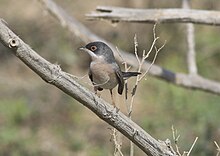Menetries's warbler
| Menetries's warbler | |
|---|---|

| |
| Scientific classification | |
| Domain: | Eukaryota |
| Kingdom: | Animalia |
| Phylum: | Chordata |
| Class: | Aves |
| Order: | Passeriformes |
| Family: | Sylviidae |
| Genus: | Curruca |
| Species: | C. mystacea
|
| Binomial name | |
| Curruca mystacea (Ménétries, 1832)
| |
| Synonyms | |
|
Sylvia mystacea | |
Menetries's warbler or Ménétries's warbler (Curruca mystacea) is a small
Description
The Menetries's warbler is 12 to 14 cm long with a wingspan of 15 to 19 cm and weighs about 9-11 grams. Its fairly long tail is blackish with white on the outer-feathers and is often held cocked. It is frequently wagged up and down or from side to side. The bill is fairly heavy and is dark with a pinkish patch at the base. There is a pale bare ring around the eye.

The male of the nominate subspecies C. m. mystacea is dark greyish above and whitish below with a white submoustachial stripe and a pink throat and breast. It has a dark cap which is dull black at the front but becomes paler further back and merges into the grey nape unlike the Sardininan warbler which has an entirely jet-black cap. Menetries's warblers have rather plain tertial feathers unlike the Sardinian warbler which has tertials with more obvious dark centres and pale edges. The western subspecies S. m. rubescens is paler grey above than the nominate and the pink on the underparts is paler or absent entirely. The eastern subspecies C. m. turcmenica is paler grey above and paler pink below than the nominate and has longer wings than both the other subspecies. Male Menetries's warblers become browner outside the breeding season with a less dark cap.
The female is sandy grey-brown above and buff-white below. It is similar to female Sardinian and eastern subalpine warblers but has plainer tertial feathers and more contrast between the pale back and dark tail. First-winter males are similar to females but may have some pink on the throat and breast.
The species has a harsh, buzzing call, as well as a sparrow-like chattering call. The
Distribution
It is a migratory bird, nesting in
The winter range covers southern
.Ecology
It occurs in
Reproduction
The cup-shaped
References
- . Retrieved 20 October 2022.
- Harris, Alan; Shirihai, Hadoram & Christie, David (1996) The Macmillan Birder's Guide to European and Middle Eastern Birds, Macmillan, London.
- Harrison, Colin (1975) A Field Guide to the Nests, Eggs and Nestlings of British and European Birds, Collins, London.
- Hollom, P. A. D.; Porter, R. F.; Christensen, S. & Willis, Ian (1988) Birds of the Middle East and North Africa, T & AD Poyser, Calton, England.
- Lewington, Ian; Alström, Per & Colston, Peter (1991) A Field Guide to the Rare Birds of Britain and Europe, HarperCollins.
- Roselaar, C. S. (1995) Songbirds of Turkey: an atlas of biodiversity of Turkish passerine birds, Pica Press, UK.
- Snow, D. W. & Perrins, C. M. (1998) Birds of the Western Palearctic: Concise Edition, Vol. 2, Oxford University Press, Oxford.

